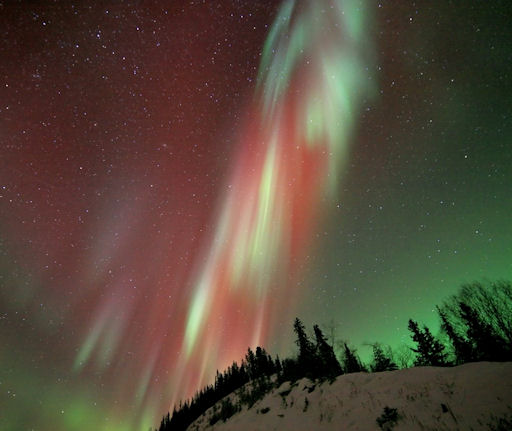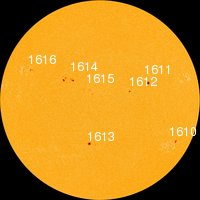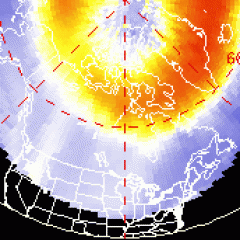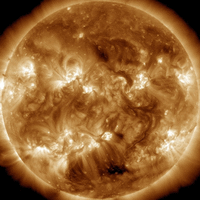CHANCE OF FLARES: NOAA forecasters estimate a 40% chance of M-class solar flares and a 5% chance of X-flares today. The most likely sources would be sunspots AR1610 and AR1614, which have unstable 'beta-gamma' magnetic fields. Eruptions from AR1614 would likely be Earth-directed. Solar flare alerts: text, voice.
RED AURORAS: Auroras are usually green, and sometimes purple, but seldom do sky watchers see much red. The geomagnetic storm of Nov. 13/14 was different. It produced auroras with a distinctly rosy hue. David E. Cartier, Sr. photographed the phenomenon near Marsh Lake, about 40 km east of Whitehorse in Canada's Yukon Territory:
"I was amazed by the deep scarlet color, which was immediately recognizable to the unaided eye," says Cartier. Similar splashes of candy-cane red were spotted over Wisconsin and Michigan.
The apparition might be related to rare all-red auroras sometimes seen during intense geomagnetic storms. They occur some 300 to 500 km above Earth's surface and are not yet fully understood. Some researchers believe the red lights are linked to a large influx of low-energy electrons. When such electrons recombine with oxygen ions in the upper atmosphere, red photons are emitted. At present, space weather forecasters cannot predict when this will occur.
Could more reds be in the offing? NOAA estimates a 30% to 35% chance of polar geoagnetic storms on Nov. 16th and 17th. Sky watchers seeing red should submit their images here. Aurora alerts: text, voice.

![]()
Solar wind
speed: 401.9 km/sec
density: 1.9 protons/cm3
explanation | more data
Updated: Today at 1516 UT
![]()
X-ray Solar Flares
6-hr max: C1 0901 UT Nov16
24-hr: C1 0756 UT Nov16
explanation | more data
Updated: Today at: 1500 UT
![]()
![]()
![]()
Daily Sun: 16 Nov 12
![]()
![]()
Sunspots AR1610 and AR1614 pose a threat for M-class solar flares. Credit: SDO/HMI
![]()
![]()
![]()
Sunspot number: 132
What is the sunspot number?
Updated 16 Nov 2012
Spotless Days
Current Stretch: 0 days
2012 total: 0 days (0%)
2011 total: 2 days (<1%)
2010 total: 51 days (14%)
2009 total: 260 days (71%)
Since 2004: 821 days
Typical Solar Min: 486 days
Update 16 Nov 2012
The Radio Sun
10.7 cm flux: 141 sfu
explanation | more data
Updated 16 Nov 2012
![]()
![]()
![]()
Current Auroral Oval:
![]()
Switch to: Europe, USA, New Zealand, Antarctica
Credit: NOAA/POES
![]()
![]()
![]()
Planetary K-index
Now: Kp= 1 quiet
24-hr max: Kp= 2 quiet
explanation | more data
![]()
Interplanetary Mag. Field
Btotal: 3.4 nT
Bz: 2.5 nT south
explanation | more data
Updated: Today at 1516 UT
![]()
![]()
![]()
Coronal Holes: 15 Nov 12
![]()
![]()
There are no large coronal holes on the Earthside of the sun. Credit: SDO/AIA.





